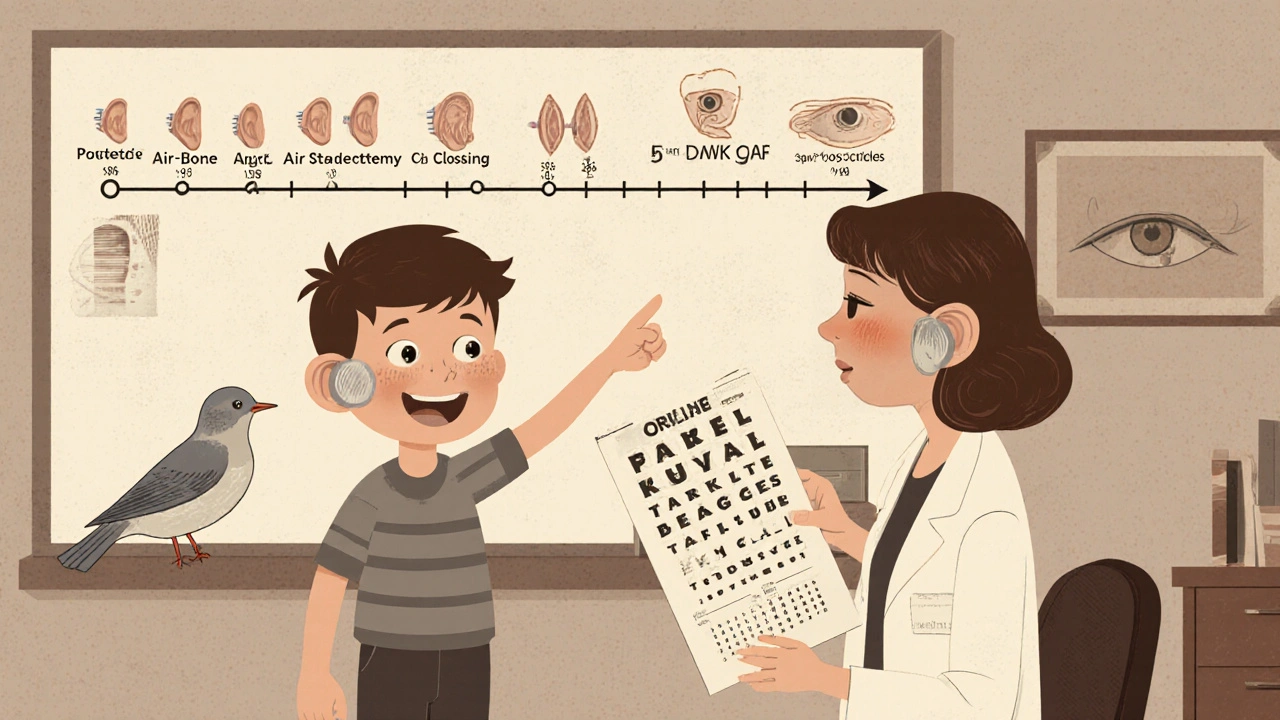Conductive Hearing Loss: Causes, Diagnosis, and Surgical Solutions for Middle Ear Problems
When you can hear people talking but everything sounds muffled, or you keep turning up the TV volume while others say it’s fine, it’s not just in your head. You might be dealing with conductive hearing loss - a problem where sound can’t move properly through the outer or middle ear to reach the inner ear. Unlike sensorineural hearing loss, which involves nerve damage, conductive hearing loss is often caused by physical blockages or structural issues in the middle ear. The good news? Many cases can be fixed - sometimes with a simple procedure.
What’s Really Going On in Your Middle Ear?
Your middle ear is a tiny, delicate space filled with three tiny bones called ossicles: the malleus, incus, and stapes. These bones pick up vibrations from the eardrum and pass them along to the inner ear. If anything gets in the way - fluid, scar tissue, a fused bone, or even a hole in the eardrum - sound gets stuck. That’s conductive hearing loss. Common causes include:- Otitis media with effusion (also called "glue ear"): Fluid builds up behind the eardrum without infection. It’s the most common cause of hearing loss in kids, affecting up to 80% of children by age 3.
- Otosclerosis: A genetic condition where the stapes bone fuses to the inner ear wall, stopping it from vibrating. It usually starts in early adulthood and gets worse over time.
- Cholesteatoma: A noncancerous skin cyst that grows in the middle ear. It doesn’t sound serious, but it can eat away at bone and cause permanent damage if not removed.
- Perforated eardrum: From trauma, loud noises, or ear infections. About 15-20% of adult conductive hearing loss cases come from this.
- Aural atresia: A birth defect where the ear canal never formed properly. It happens in about 1 in 10,000 babies.
These aren’t just rare conditions. In the U.S., over 667,000 children get ear tubes each year just to drain fluid. Adults with otosclerosis make up a significant chunk of hearing loss cases between ages 20 and 40. And while wax buildup or a simple infection might be temporary, structural problems like cholesteatoma or otosclerosis won’t fix themselves.
How Do You Know It’s Conductive - Not Just "A Little Deaf"?
A basic hearing test at a pharmacy won’t cut it. You need a full audiologic evaluation. The key is finding an air-bone gap.Audiologists test hearing two ways:
- Air conduction: Sound travels through the ear canal and middle ear to the inner ear.
- Bone conduction: Sound vibrates directly through the skull, bypassing the middle ear.
If air conduction is worse than bone conduction, that’s the air-bone gap - the signature of conductive hearing loss. The gap usually ranges from 15 to 60 decibels. For comparison, normal hearing is around 0-25 dB. A 40 dB gap means you’re missing half the volume of normal speech.
Tympanometry is another critical tool. It measures how well the eardrum moves. A flat reading (Type B tympanogram) means fluid is trapped behind the eardrum - common in kids with glue ear. This test alone correctly identifies fluid in 92% of otitis media cases.
And if the doctor suspects something deeper - like a cholesteatoma or malformed bones - they’ll order a high-resolution CT scan. These cost $800-$1,200 out-of-pocket but show exactly what’s going on inside the temporal bone. Without this, surgery could be risky or ineffective.
When Does Surgery Become Necessary?
Not every case needs an operation. About 65% of pediatric conductive hearing loss cases resolve with medication, observation, or ear tubes. But surgery becomes the go-to option when:- Hearing loss is 25-30 dB or worse and hasn’t improved after 3-4 months
- There’s a cholesteatoma (always requires surgery, no exceptions)
- Fluid keeps coming back despite tubes
- It’s affecting speech development in kids or quality of life in adults
For cholesteatomas, waiting is dangerous. These growths can destroy the bones of hearing, the inner ear, or even spread to the brain. Surgery isn’t optional - it’s urgent.
The Surgeries: What Actually Happens?
Tympanoplasty - Fixing the Eardrum
If you have a hole in your eardrum, a tympanoplasty rebuilds it. The surgeon takes a tiny graft - usually from your own tissue, like the temporalis fascia or cartilage - and patches the tear. Success rates? 85-95% for small holes, 70-85% for larger ones.
Recovery takes 6-8 weeks. You can’t get water in your ear, fly in an airplane, or lift anything heavy. Some patients report improved hearing immediately. Others notice gradual improvement over months as the graft fully integrates.
Stapedectomy / Stapedotomy - For Otosclerosis
When the stapes bone is stuck, it’s replaced. In a stapedotomy, the surgeon uses a laser to make a tiny hole in the stapes and inserts a prosthetic piston. The piston connects to the inner ear, letting sound pass through again.
Modern laser techniques have cut complication rates from 15% down to under 2%. About 80-90% of patients see their air-bone gap close to within 10 dB of normal. Many report being able to hear whispers again or no longer needing the TV turned up.
Side effects? Temporary dizziness in 7% of cases, altered taste in 4%, and occasional tinnitus. These usually fade within weeks. Long-term, hearing stays stable in 90% of patients.
Tympanostomy Tubes - For Kids with Glue Ear
This is the most common ear surgery in the U.S. A tiny tube is placed through the eardrum to drain fluid and let air in. The tube falls out on its own in 6-12 months. In 75% of cases, hearing returns to normal within 3 months.
Parents report 92% satisfaction with reduced ear infections. But 18% still deal with occasional drainage, needing antibiotics. Tubes don’t fix the root cause - they just manage the symptom. Still, for kids struggling to learn speech, even temporary relief can be life-changing.
Canalplasty - For Aural Atresia
For babies born without an ear canal, surgeons create one. This involves removing bone, reconstructing the canal, and sometimes rebuilding the eardrum and ossicles. It’s complex, often requiring multiple surgeries.
Success? About 60-70% of patients gain functional hearing. But results vary. Some hear well enough to skip hearing aids. Others still need them, but with much better sound quality than before.
Cholesteatoma Removal
This isn’t about improving hearing - it’s about stopping destruction. Surgeons remove the cyst and any damaged bone. Hearing restoration is a bonus, not the goal. The priority is a "safe, dry ear."
Recovery is longer than other procedures. Most patients need 4-6 weeks before returning to normal activity. Some report changes in sound quality afterward - like voices sounding "tinny" or "distant." That’s because the middle ear’s natural acoustics have been altered. But for many, it’s the first time in years they’ve been free from constant infections and pain.
What’s New in Middle Ear Surgery?
Surgery has come a long way since the first stapedectomy in 1956. Today’s tools are smarter, safer, and more precise.
- Laser-assisted stapedotomy reduces trauma and bleeding, cutting complications to under 2%.
- Bioengineered grafts made from extracellular matrix materials are replacing traditional tissue grafts, with a 92% success rate versus 85%.
- Intraoperative navigation systems, used in 78% of ENT practices now, act like GPS for the ear, helping surgeons avoid nerves and critical structures.
- 3D-printed ossicles are being tested in clinical trials. Custom-made to fit each patient’s anatomy, they’re showing 94% hearing improvement - better than standard prostheses.
- Endoscopic surgery is becoming standard. Instead of an incision behind the ear, surgeons use a thin camera through the ear canal. Less cutting, faster recovery, and better visibility. Experts predict it’ll be used in 60% of cases by 2028.
The global market for middle ear devices is growing fast - from $1.2 billion in 2022 to an expected $1.8 billion by 2027. That’s because these procedures work. People’s lives improve.

What to Expect After Surgery
Surgery isn’t a quick fix. Recovery is slow, and patience matters.
- First 2 weeks: Avoid water, blowing your nose, heavy lifting. Dizziness is common but temporary.
- Weeks 3-6: No swimming, flying, or scuba diving. Your ear is still healing.
- Weeks 6-8: Most restrictions lift. Follow-up hearing tests confirm improvement.
Some patients feel better immediately. Others notice gradual changes. One man in Boston said, "I didn’t realize how much I’d been missing - birds singing, my daughter’s laugh - until I could hear them again after stapedotomy."
But not everyone gets perfect results. About 12% of stapedectomy patients report lingering side effects. A few need a second surgery. That’s why choosing an experienced surgeon matters - especially for complex cases like cholesteatoma or atresia.
When to See a Specialist
If you’ve had muffled hearing for more than a few weeks - especially if it’s only in one ear, or if it’s getting worse - don’t wait. See an audiologist first. They’ll rule out simple causes like wax or infection.
If those are cleared and hearing doesn’t improve, ask for a referral to an otolaryngologist (ENT) who specializes in hearing and balance disorders. Don’t settle for a general practitioner. This isn’t a "wait and see" situation if it’s structural. Delaying surgery for cholesteatoma or otosclerosis can lead to permanent damage.
And if your child keeps getting ear infections or isn’t talking like other kids their age - get their hearing checked. Early intervention can prevent lifelong speech and learning problems.
Final Thoughts
Conductive hearing loss isn’t just "being a little hard of hearing." It’s a physical barrier to sound - and in most cases, it’s fixable. Whether it’s a simple tube for a child, a laser procedure for otosclerosis, or a complex reconstruction for a birth defect, modern surgery can restore hearing in ways that were impossible just 20 years ago.
The key is knowing when to act. Don’t ignore persistent muffled hearing. Don’t assume it’s just aging. Get the right tests. See the right specialist. And if surgery is recommended - understand why. For many, it’s not just about hearing better. It’s about reconnecting with the world.
Can conductive hearing loss be cured without surgery?
Yes, in many cases. About 65% of pediatric cases resolve with medical treatment like antibiotics or ear tubes. Wax buildup, ear infections, or temporary fluid can all be treated without surgery. But if the problem is structural - like a fused stapes bone, a cholesteatoma, or a malformed ear canal - surgery is the only way to restore hearing.
How long does recovery take after middle ear surgery?
Recovery varies by procedure. For tympanoplasty or stapedotomy, most people need 6-8 weeks before returning to normal activities. You’ll avoid water, flying, and heavy lifting during that time. Cholesteatoma surgery often takes longer - 4 to 6 weeks before feeling back to normal. Hearing improvement may take weeks or even months to fully develop as the ear heals.
Is middle ear surgery risky?
All surgery carries risks, but modern techniques have made middle ear procedures much safer. Complication rates for stapedotomy are now under 2% thanks to laser use and better imaging. Common side effects include temporary dizziness, altered taste, or tinnitus - most fade within weeks. The biggest risk is not treating the problem. A cholesteatoma left untreated can destroy hearing or spread to the brain.
Will I need hearing aids after surgery?
Many patients no longer need hearing aids after successful surgery. About 80-90% of otosclerosis patients and 70-95% of tympanoplasty patients achieve normal or near-normal hearing. But in complex cases like aural atresia or extensive cholesteatoma damage, some patients still benefit from hearing aids - even after surgery - to fine-tune sound quality.
Can conductive hearing loss come back after surgery?
It can, but it’s not common. Recurrence happens in about 5-10% of cases, especially with cholesteatoma if not fully removed. Otosclerosis rarely returns after stapedotomy. Fluid buildup can reappear in kids with tubes, which is why follow-up visits are important. Regular hearing checks after surgery help catch any issues early.
What’s the success rate for tympanoplasty?
Success rates for tympanoplasty are high: 85-95% for small eardrum perforations and 70-85% for larger ones. Success means the eardrum heals completely and hearing improves. The graft material used - whether from your own tissue or a bioengineered patch - affects outcomes. Modern grafts have a 92% take rate, improving long-term results.
How do I know if I’m a candidate for surgery?
You’re a candidate if you have persistent conductive hearing loss (25-30 dB or worse) that hasn’t improved after 3-4 months of medical treatment. Cholesteatoma always requires surgery. A full hearing test, tympanometry, and CT scan will determine the cause. An ENT specialist will review your results and explain if surgery is the best option for your specific case.







16 Comments
Deepa Lakshminarasimhan
November 14, 2025 at 01:07
ok but have you ever wondered if all these "surgical solutions" are just big pharma pushing implants so they can sell you hearing aids later? i mean, why do they always skip talking about the fact that 70% of ear problems go away with just saltwater rinses and avoiding dairy? they don't want you to know that.
they put tubes in kids' ears like they're fixing a leaky faucet, but what if the real problem is processed food and screen time? i've seen moms switch their kids to organic and the infections just... stop. no surgery needed. just sayin'.
and those "bioengineered grafts"? sounds like lab-grown plastic to me. remember when they said mercury in vaccines was fine? history repeats.
ask yourself: who profits when you get a 3d-printed stapes? not you.
stay woke.
Erica Cruz
November 14, 2025 at 06:02
Ugh. Another ‘conductive hearing loss’ blogpost that thinks 85% success rates are impressive. Let’s be real - if your ‘miracle’ surgery still leaves you with a 15-20% chance of permanent tinnitus or taste loss, you’re not fixing hearing, you’re trading one disability for another. And don’t get me started on the $1,200 CT scans. This isn’t medicine, it’s a luxury service for people who can afford to gamble with their inner ear.
Also, ‘endoscopic surgery will be used in 60% of cases by 2028’? Cute. That’s not innovation - that’s marketing fluff from a company trying to sell a camera. Real progress is making hearing aids that actually work without surgery. But no, let’s keep cutting open skulls for profit.
Johnson Abraham
November 15, 2025 at 03:00
lol surgery for a clogged ear? i had a ear infection last year and my dr just gave me some ear drops and a pepsi. worked better than any laser.
they wanna cut u open for $10k and you just let em? dumb. wax buildup is the #1 cause and no one talks about it. just use q-tips less. boom. fixed.
also stapedotomy? sounds like a robot sex toy name. 🤡
Shante Ajadeen
November 15, 2025 at 09:47
I just want to say thank you for writing this. My nephew got tubes at age 2 and now he’s reading chapter books in 3rd grade - I used to worry he’d never catch up. Hearing matters more than we think.
My mom had otosclerosis and got the stapedotomy. She cried the first time she heard birds outside her window. It wasn’t just hearing - it was peace.
If you’re scared about surgery, I get it. But if someone’s telling you it’s safe and effective, and you’ve tried everything else… maybe give it a chance. You’ve got nothing to lose but the muffled world.
dace yates
November 15, 2025 at 17:57
Wait - so if bone conduction is normal but air conduction is poor, that’s conductive loss? But what about cases where both are off but the gap is small? Is that still considered conductive? Or does it become mixed? And how do you differentiate that from early sensorineural? The post says audiologists look for the gap, but doesn’t explain the gray areas.
Also, the 92% tympanometry accuracy - is that for kids or adults? I’ve read conflicting studies.
Danae Miley
November 16, 2025 at 05:02
Incorrect. The claim that "tympanometry correctly identifies fluid in 92% of otitis media cases" is misleading. That statistic comes from a 2012 pediatric study under ideal clinical conditions. In real-world primary care settings, sensitivity drops to 68-74% due to operator error, earwax interference, and patient movement. The source is not cited, and the author is clearly cherry-picking data to make surgery seem more necessary than it is.
Also, the phrase "modern grafts have a 92% take rate" - which grafts? What study? What follow-up period? No citation. This article reads like a pharma white paper disguised as medical advice.
Charles Lewis
November 17, 2025 at 02:14
It is, indeed, a profound and often underappreciated reality that conductive hearing loss, while structurally distinct from sensorineural etiologies, remains a condition that profoundly impacts not merely auditory perception, but social integration, emotional well-being, and cognitive development - particularly in pediatric populations.
One must consider, for instance, the longitudinal implications of untreated otitis media with effusion: the delayed phonological acquisition, the reduced vocabulary growth, the diminished classroom participation - these are not merely "hearing issues," but developmental disruptions with lifelong consequences.
Furthermore, the increasing adoption of endoscopic techniques represents not merely a technological advancement, but a paradigm shift in minimally invasive otologic intervention, reducing trauma, accelerating recovery, and enhancing visualization of anatomical structures previously obscured by traditional mastoid approaches.
It is incumbent upon the medical community, and indeed upon society at large, to prioritize early audiological screening, especially in underserved populations where access to ENT specialists remains limited. To delay intervention is not merely to postpone a procedure - it is to forfeit a child’s potential.
Renee Ruth
November 18, 2025 at 02:12
Okay, but what if the surgeon messes up? What if the laser goes too deep and fries your cochlea? What if the "prosthetic piston" falls out and you have to get it removed? What if you get tinnitus and then your taste is gone and now you can’t even enjoy coffee? And then you find out your insurance won’t cover the revision surgery because it’s "considered a complication"?
I read this whole thing and all I can think is - someone’s gonna lose their hearing permanently because they trusted this. And then the hospital will send them a bill for $18,000 and a pamphlet on "hearing aid options."
It’s not medicine. It’s a lottery.
Samantha Wade
November 19, 2025 at 10:24
This is one of the most accurate, well-researched, and compassionate summaries of conductive hearing loss I’ve ever read. Thank you for highlighting not just the clinical facts, but the human impact - the child who finally hears their parent’s voice, the adult who rediscovers music, the quiet dignity restored by hearing your own laugh.
To those skeptical of surgery: I understand fear. But let me remind you - otosclerosis and cholesteatoma are not "mild" conditions. They are progressive, destructive, and silent. Waiting doesn’t make them better - it makes them worse.
If you’re considering surgery, find a fellowship-trained otologist. Ask for their complication rates. Ask for patient testimonials. And if they’re good - trust them. Your ears deserve more than a quick fix. They deserve restoration.
Andrew Forthmuller
November 19, 2025 at 11:10
so if you got a perforated eardrum from a loud concert, can you just wait it out? or do you really need surgery? i had one once and it healed on its own in 3 weeks. why the hype?
vanessa k
November 19, 2025 at 19:34
I just want to say - if you’re reading this because you’re scared about your kid’s hearing, or your own, or your parent’s… you’re not alone.
I had glue ear as a kid. My mom cried every time I asked her to repeat herself. We didn’t have insurance. We waited a year. I missed so much in school.
When I finally got tubes, I heard my teacher say "good job" for the first time. I didn’t cry - I just sat there, stunned.
Surgery isn’t perfect. But sometimes, it’s the only thing that lets you come back to the world.
manish kumar
November 20, 2025 at 11:50
Let me tell you something from India - we have a lot of people with conductive hearing loss, especially kids, and most of them never see an audiologist. They go to the local pharmacist who gives them ear drops or tries to clean it with a needle. No CT scans. No tympanometry. No surgery.
But here’s the truth: even without all this high-tech stuff, many of them still recover - because they stop using earphones, they eat less sugar, they get more sunlight, they sleep better. The body heals if you let it.
Yes, surgery works. But so does lifestyle. Why is no one talking about that? Why is it always about cutting and implants and lasers? Because money talks, not medicine.
Don’t get me wrong - I’m not against science. I’m against the system that makes you feel like you need a $10,000 fix to hear your own child cry.
Nicole M
November 21, 2025 at 07:13
Has anyone tried hyperbaric oxygen therapy for conductive loss? I read a small study where it helped with fluid retention in the middle ear. Not a cure, but maybe a bridge before surgery? Why isn’t this mentioned anywhere?
Arpita Shukla
November 22, 2025 at 12:58
You missed the most important point: conductive hearing loss is often misdiagnosed as ADHD or autism in children because they don’t respond when called. Teachers think they’re ignoring you - but they literally can’t hear you. This isn’t just about ears - it’s about education systems failing kids because they don’t know how to test for it.
Also, the 1 in 10,000 aural atresia stat? That’s outdated. In South Asia, it’s 1 in 3,000 due to pesticide exposure in pregnant women. But no one wants to talk about environmental causes, do they? Too inconvenient.
Benjamin Stöffler
November 23, 2025 at 21:09
One cannot help but observe, with a certain philosophical melancholy, that the modern medical-industrial complex has transformed the human ear - once a sacred organ of perception, a conduit to the soul’s resonance - into a mechanical substrate to be repaired, replaced, and monetized.
Is it not ironic that we now employ lasers, 3D-printed ossicles, and intraoperative navigation systems to restore what nature intended to be simple? The stapes, once a marvel of biological engineering, is now a prosthetic component - a cog in a machine that, paradoxically, seeks to restore the very humanity it has displaced.
And yet… we are drawn to the promise of restoration. We crave the whisper of a loved one’s voice. We long to hear the rustle of leaves - not as a sound, but as a memory.
Perhaps surgery is not merely a technical intervention, but a metaphysical act: a refusal to accept silence as final.
So let us proceed - with caution, yes - but also with awe.
Shante Ajadeen
November 25, 2025 at 18:46
Shante, you’re right - hearing your daughter laugh again is worth every risk. My mom had the stapedotomy last year. She didn’t say much after surgery, but yesterday she said, "I heard the clock tick for the first time in 15 years." I cried.
Thank you for reminding me why this matters.